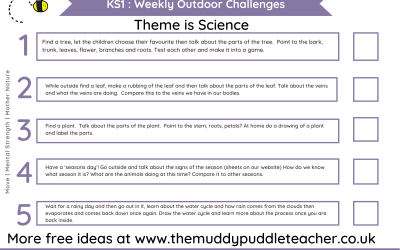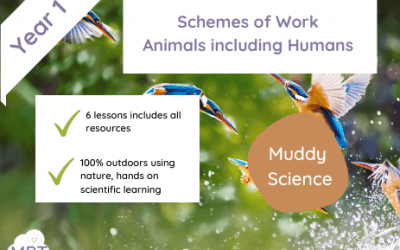Join in with Sunflower Day and use Plant a Sunflower Seed (Instructions) to make life easier for you and to embed some...
Sunflower Day Growth Chart – EYFS/KS1
Apr 11, 2021
EYFS/KS1 - Enjoy using this resource on Sunflower Day so that the children can record the height and observe their...
Muddy Science Day (Parent Letter)
Feb 27, 2021
Use Muddy Science Day (Parent Letter) to inform parents about this special day. Part of the children’s curriculum is...
KS1 Home Learning Pack
Feb 27, 2021
Use KS1 Home Learning Pack to help parents get their children out in active and fun ways while still embedding...
eBook Phase 3 – Book 1 (jvwx)
Jan 27, 2021
Use the eBook Phase 3 - Book 1 to practice these sounds jvwx. This is an interactive book that the children will...
*FREE*Signs of Autumn Explorer Sheet
Jan 27, 2021
Use the Signs of Autumn Explorer Sheet to get the children outside applying their Science and wonder of the world the...
*FREE* KS1 Weekly Outdoor Learning Challenges (Theme Science)
Jan 24, 2021
KS1 Weekly Outdoor Learning Challenges (Theme Science)
Signs of Spring Activity Sheet
Jan 22, 2021
Use the Signs of Spring Activity Sheet to get the children outside applying their Science and knowledge in an active...
Signs of Winter Activity Sheet
Jan 22, 2021
Use the Signs of Winter Activity Sheet to get the children outside applying their Science and knowledge in an active...
*FREE*Butterfly Spotter Activity Sheet
Jan 22, 2021
Use the Butterfly Spotter Activity Sheet to get the children outside applying their Science and knowledge in an active...
Lesson 1: Bird Spotter Activity Sheet
Jan 22, 2021
Use the Bird Spotter Activity Sheet to get the children outside applying their Science and knowledge in an active way....
Autumn Colour Spotter Sheet Activity
Jan 22, 2021
Use the Autumn Colour Spotter Activity Sheet to get the children outside applying their maths while they connect with...
Summer Colour Spotter Activity Sheet
Jan 22, 2021
Use the Summer Colour Spotter Activity Sheet to get the children outside applying their maths while they connect with...
Spring Spotter Activity Sheet
Jan 22, 2021
Use the Spring Spotter Activity Sheet to get the children outside applying their maths while they connect with nature...
Winter Colours Art Activity Sheet
Jan 21, 2021
Use the fabulous Winter Colours Art Activity Sheet to get the children outside applying their maths while they connect...
Winter Colour Spotter Activity Sheet
Jan 21, 2021
Use the mud-tastic Winter Colour Spotter Sheet to get the children outside applying their maths while tey connect with...
Year 1 Animals Including Humans (Brilliant Birds)
Jan 19, 2021
Completely 100% outdoor scheme of work for Year 1 Animals Including Humans! Use Year 1 Animals Including Humans Scheme...
*FREE*Daily Outdoor Challenges KS1 – Nature Theme
Jan 18, 2021
Daily Outdoor Challenges KS1 Nature Theme Let the Muddy Puddle Teachers help you with the lockdown and get free whole...
New In

KS3 Outdoor Art Ideas Pack

Fractions KS1 Ideas Pack

Craft Ideas for Babies in Autumn

Adjectives in Autumn KS1

My Senses in Autumn (KS1)

Parachute Games Knowledge and Understanding of the World

25 Parachute Games (PSED)

Lanyard Challenges Sand Area (Underwater Theme)

Mud Kitchen Posters – Christmas Theme




















